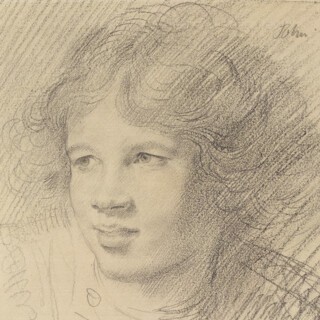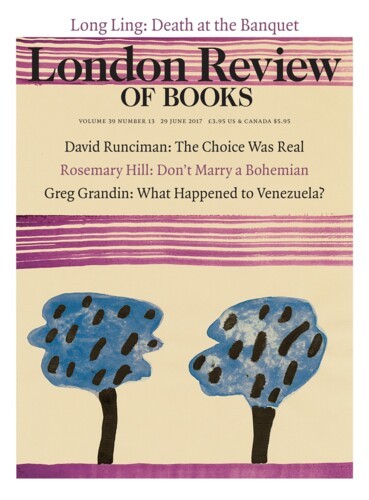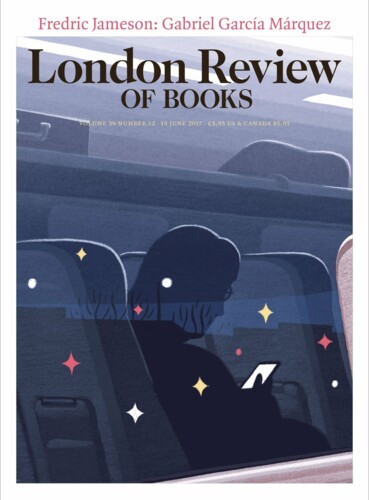Bohemia was never a safe country for women. If they didn’t all die of consumption in a garret, many of them might as well have done. In the 1890s, when the ‘new woman’ sprang, as Max Beerbohm put it, ‘fully armed from Ibsen’s brain’, their cases tended to follow a pattern. Attracted by the idea of freedom from social and sexual convention and the chance to live among artists, even to be artists, they found themselves not in a new world but in a mirror image of the old, with as many constraints and fewer comforts. The hoped for careers rarely developed. The bohemian man may have idealised women as muses and models but he was unhampered by bourgeois obligations to be faithful or to earn money, though rarely was he so unconventional as to undertake any housework or childcare. The bohemian woman with children was as much shackled to domesticity as any solicitor’s wife, but without the staff a middle-class household would command or the security. Meanwhile the door to a respectable life had slammed shut behind her.
Such, more or less, is the story of Ida Nettleship, the first wife of Augustus John, who died of puerperal fever at the age of 30 in 1907 and was soon lost to view. In John’s unfinished mural Lyric Fantasy, painted soon after her death, Ida stands to one side of the group of women and children who make up the extended John ménage, a monumental figure in deep shadow. In his memoir, Chiaroscuro, published in 1952, John made no mention of her. Her five sons, the eldest of whom was five when she died, seem to have known little about their mother. The letters, published here for the first time, go a long way to recovering her and tell a painful story of an emotionally sophisticated, morally honest woman struggling with the trap in which she finds herself, trying by turns to escape and to take control of the situation. To different correspondents she showed different facets of her predicament and the result is a portrait both fragmentary and poignant.
The Nettleships were an artistic family. Ida’s father, John Trivett, was a painter of some repute, though remembered by W.B. Yeats chiefly for his ‘melodramatic lions’; her mother, Adaline, was a dressmaker and theatrical costumier. She created the famous iridescent gown, covered in beetle wings, in which Ellen Terry played Lady Macbeth and in which Sargent painted her in 1889. The picture, ‘the sensation of the year’ according to Terry’s diary, shows her snakelike in her glistening robe holding the crown of Scotland above her head, an embodiment of dangerous female sexuality. When it was painted she was 41 with three marriages behind her. Ida was 12 and whether or not she saw the painting she grew up in a milieu where such lives were known to be possible. It was this, perhaps, that made her mother determined to keep a tight rein on her three daughters. Adaline’s moral code was worked out in what Michael Holroyd in his introduction memorably terms the ‘moral gymnasium’ of the last Victorian decades. He characterises it, too harshly, as a culture of ‘conceit and condemnation
Ida was 15 when she enrolled at the Slade School of Fine Art, where her father had studied, arriving just in time for the Slade’s golden age, at the heart of which were Augustus John and his sister Gwen. They had come to London to study under the irascible but inspiring Henry Tonks and soon attracted a group of talented students around them. ‘Those Johns you know have a hold that never ceases,’ Ida wrote to a friend. She stayed for six years, working hard to be an artist and making friendships that lasted all her life. Among her fellow students were some of the 14 children of the wealthy Salaman family whose father had made a fortune in the ‘feather boom’ of the 1880s when fabulous prices were paid for ostrich plumes. Ida became engaged to Clement Salaman. She liked him perfectly well. He was reliable, suitable and fond of her. They might have been happy enough had not her ‘beautiful warm face’ caught the eye of Augustus John. Then she knew what it was to have a grand passion and to be on the horns of a dilemma. Her parents would not agree to a marriage and she would not agree to sex without one. Augustus visited the Nettleship home in Wigmore Street, thereby making matters worse. His long-haired Gypsyish appearance was against him and since he was afraid of saying the wrong thing he said nothing. He and Mrs Nettleship regarded one another in hostile silence until, in 1901, the deadlock was broken with a discreet trip to St Pancras Register Office.
Ida’s letters before her marriage suggest a lively mind emerging from the chrysalis of late Victorian girlhood with its peculiarly prescribed emotional range. Like many of her contemporaries she wrote to other women in extravagant terms: ‘I am so lonely,’ she told her fellow student Edna Waugh, ‘I love you dear dear – & please love me.’ But there are also flashes of Wildean sensibility. ‘Wouldn’t it be lovely to be free
Ida advised her friend to stick to her course and be an artist: ‘Don’t get down side paths
After their marriage, which Ida’s father glossed to friends as having been ‘private’ rather than clandestine, things went well at first. Augustus got a job teaching art at University College, Liverpool and they found the city lively and cosmopolitan. Ida painted, using ‘an old man model’ who sat ‘like a rock’. They made friends. By the autumn she was pregnant and adapting her wardrobe. Adaline was asked for a ‘loose black lace evening blouse
That year a further and permanent complication arrived in the form of Dorothy McNeill, known as Dorelia, a 21-year-old secretary who spent her evenings at the Westminster School of Art. It was Gwen John who met her first and soon she and Augustus were captivated and determined to have her for themselves. They painted her repeatedly and, as she sometimes felt in the early days, relentlessly. What it was about Dorelia that exerted such fascination is difficult now to know. Perhaps like Janey Morris she had to be seen to be believed, though the effect was due only partly to her looks. Nicolette Devas, who was later absorbed as a child into the John household, recalled the impression she made on a sharp but innocent eye:
Hers was a fierce beauty, a dark, austere beauty with something of the peasant
... She frightened people. If the visitor was lucky he received a repressive ‘Hello’ in that deep, husky voice her children have inherited. Her silences were unforced by theory; she was incapable of small talk, and only spoke in short barks, and disappeared again, wrapped in her mystery and protected by her dignity.
Ida with her bothersome babies and her domestic ‘serfdom’ stood little chance against the Johns’ shared passion. From now she was the awkward third in two triangles. In her marriage she shared her husband with Dorelia. Outside it she shared him with the ‘impitoyable’ Gwen. The siblings generated a forcefield, as they had at the Slade, and their obsession with Dorelia drew her to them; though reluctant at first, she was soon sucked in and digested like an insect in a Venus flytrap. Ida found various ways of squeezing up her eyes to make it look a better fit. She and Augustus had taken a house at Matching Green in Essex from where Ida wrote defensively to Alice Rothenstein, a friend from Liverpool days:
You know that we are not a conventional family. You have heard Dorelia is beautiful and most charming, and you must learn that my only happiness is for [Augustus] to be happy and complete, and that far from diminishing our love for each other it appears to augment it. I do have my bad times
... She is so remarkably charming. But those times are... not the truth.
The bad times were heard more often in the letters to the Rāni in which Ida seemed to go back to the most interesting time of her life and imagine the different routes she might have taken from that point. ‘It suddenly strikes me how perfectly divine it would be if you and I were living in Paris together. I can imagine going to the Louvre and then back to a small room over a restaurant.’ Alternating regret, defensiveness and a determination to become the hero of her own life characterise most of the letters, but those to Dorelia have their own peculiar tone in which the emotionalism of Edwardian female friendship is laced with something like emotional sado-masochism: ‘O my honey let me say it – I crave for you to come here
Meanwhile Ida insisted that everyone including her mother must accept the situation. Mrs Nettleship, on whom Holroyd is remarkably hard, maintained a conversational rapport with her son-in-law, which was surely heroic in the circumstances. Ida herself hoped at times for ‘a different life later on’, and in the summer of 1905 she set out the case to Dorelia: ‘We have neither the peace of mind of the wife nor the freedom (at least I haven’t) of the mistress. We have the evils of both states for the one good, which belongs to both – a man’s company. Is it worth it? Isn’t it paying twice over for our boon?’ What if anything the laconic Dorelia said in reply is not explained but clearly even Augustus dimly sensed that all was not well. He came up with what perhaps only he could have considered a practical solution. Explaining that their household had become too conventional, and that what was needed was ‘an ever-changing outdoor life’, he bought a horse and caravan. While Dorelia, who was now pregnant, went with Augustus to see it, Ida, who was also pregnant, despite ‘violent efforts’ to bring on a miscarriage, turned her bravest face to Alice, assuring her that ‘it will be lovely to be camping.’ It wasn’t really. Dorelia had her baby and they called him Pyramus. Ida had her fourth child, ‘another beastly boy’ called Edwin, and for all the romance of the Gypsy life, depicted in its many ideal permutations in John’s paintings and sketches, she was exhausted, washing and looking after the children ‘from 6 or 7 until 9’ while Augustus ‘when not painting lies reading or playing with a toy boat,’ which, Ida explained to the Rāni, was quite understandable because ‘how could he paint if he had to be on duty in between – duty is so wearing & tearing.’
Ida, who had tried to live the free life, found herself the embodiment of convention. To her husband she represented ‘the dull home
The publication of her letters rights a number of wrongs, but there are frustrations. The reasons for the editors’ many excisions are not explained and there are odd misprints and mistakes such as the confusion of Yeats’s father with his brother. The account of Augustus John in the accompanying text is generous, understandably so, given that Holroyd, as his biographer, knows him from his more attractive angles and Rebecca John is his granddaughter as well as Ida’s, yet he is given the benefit of too many doubts. Describing how he began a double portrait of Ida and Dorelia and later painted Ida out, a note assures us that he did it ‘without realising the pain he gave her’, which, if true, makes him even more monstrous. Like Ida herself, Holroyd and John are inclined to blame everyone but Augustus, and poor Ada Nettleship especially, who is accused of using ‘aggressive tactics’ to try to get access to her grandchildren after her daughter’s death. She can hardly be blamed.
Without Ida the John ménage rolled on before coming to rest in Dorset where a picturesque convoy of horse-drawn carts and wagons pulled up in the summer of 1911 at Alderney Manor, ‘a rambling red brick bungalow’ in what Nicolette Devas considered ‘the worst pseudo-Gothic style’. Dorelia’s sister Edie joined them as a ‘much needed Martha’ in the household. Everyone dressed in handmade clothes so that Augustus’s paintings ‘walked about’ before him. He and Dorelia had two more children together and he had another four, each with a different woman. Offered a knighthood in the 1940s if he would regularise his life by marrying, he proposed to Dorelia, who had the integrity to turn him down – he had to make do with the Order of Merit. Neither of Ida’s sisters married but they kept in touch with their nephews. Rebecca John knew her great-aunts well in their old age but she learned nothing about Ida from them, recalling that ‘they never mentioned her to us, and we never asked.’
Send Letters To:
The Editor
London Review of Books,
28 Little Russell Street
London, WC1A 2HN
letters@lrb.co.uk
Please include name, address, and a telephone number.


